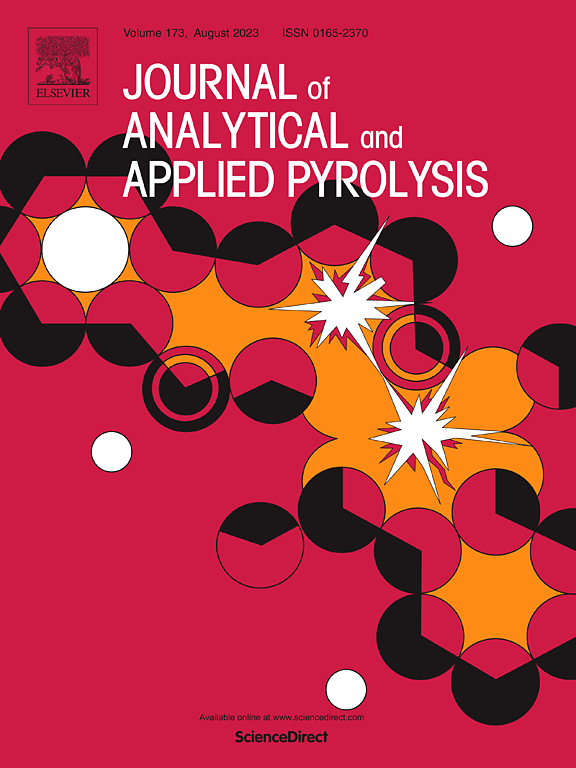Co-pyrolysis of waste wind turbine blades in a molten polyolefin medium
IF 5.8
2区 化学
Q1 CHEMISTRY, ANALYTICAL
引用次数: 0
Abstract
This study investigates the pyrolysis and co-pyrolysis processes of waste wind turbine blades (WWTB) and polyolefins (POs) at 450 °C in a round bottom tank reactor. The study contains three experimental sets: 1) batch pyrolysis of POs; 2) continuous pyrolysis of WWTB; 3) continuous feeding of WWTB into a molten PO medium, which was previously fed to the round bottom tank reactor batch-wise. Individual WWTB pyrolysis yields a modest 18.7 wt% of liquid, predominantly influenced by elevated ash and fixed carbon content. Conversely, co-pyrolysis demonstrates positive synergies, with escalating polyolefin content boosting liquid yields, reaching a peak at 61.5 wt% with a WWTB:POs mixture (25:75, wt%), while concurrently suppressing gas production to 21.6 wt%. The primary chemical groups found in the liquid obtained from WWTB are phenol and phenolic compounds, with their abundance diminishing as the POs ratio in feedstocks increases. Analysis of non-condensable gases from WWTB reveals that approximately 57.7 wt% are oxygen-containing, predominantly CO and CO2. Co-pyrolysis with POs at a 25:75 (wt%) ratio yields 47.1 wt% C3H6, resembling POs pyrolysis. The resulting solid products are rich in carbon and contains high ash. This research not only offers a detailed product analysis of WWTB but also sheds light on the dynamics of its co-pyrolysis with POs. Doing so contributes crucial insights into the transformative potential of pyrolysis and co-pyrolysis processes, covering the way for sustainable waste-to-resource solutions.
废风力涡轮机叶片在熔融聚烯烃介质中的共热解
在450 °C的圆底罐反应器中,研究了废弃风力涡轮机叶片(WWTB)和聚烯烃(POs)的热解和共热解过程。本研究包含三个实验集:1)POs分批热解;2) WWTB连续热解;3)将污水处理剂连续注入熔融的PO介质中,而之前PO介质是分批注入圆底槽式反应器的。单个WWTB热解产生适度的18.7 wt%的液体,主要受灰和固定碳含量升高的影响。相反,共热解表现出积极的协同效应,随着聚烯烃含量的增加,液体产量增加,在WWTB:POs混合物(25:75,wt%)中达到峰值61.5 wt%,同时将产气量抑制到21.6 wt%。从污水处理厂获得的液体中发现的主要化学基团是苯酚和酚类化合物,它们的丰度随着原料中POs比例的增加而减少。对WWTB中不凝性气体的分析表明,大约57.7 wt%是含氧气体,主要是CO和CO2。与POs以25:75 (wt%)的比例共热解,产率为47.1 wt% C3H6,与POs热解相似。由此产生的固体产品富含碳,含有高灰分。本研究不仅对污水处理垃圾进行了详细的产品分析,还揭示了其与POs共热解的动态。这有助于深入了解热解和共热解过程的变革潜力,为可持续的废物资源化解决方案提供了途径。
本文章由计算机程序翻译,如有差异,请以英文原文为准。
求助全文
约1分钟内获得全文
求助全文
来源期刊
CiteScore
9.10
自引率
11.70%
发文量
340
审稿时长
44 days
期刊介绍:
The Journal of Analytical and Applied Pyrolysis (JAAP) is devoted to the publication of papers dealing with innovative applications of pyrolysis processes, the characterization of products related to pyrolysis reactions, and investigations of reaction mechanism. To be considered by JAAP, a manuscript should present significant progress in these topics. The novelty must be satisfactorily argued in the cover letter. A manuscript with a cover letter to the editor not addressing the novelty is likely to be rejected without review.

 求助内容:
求助内容: 应助结果提醒方式:
应助结果提醒方式:


